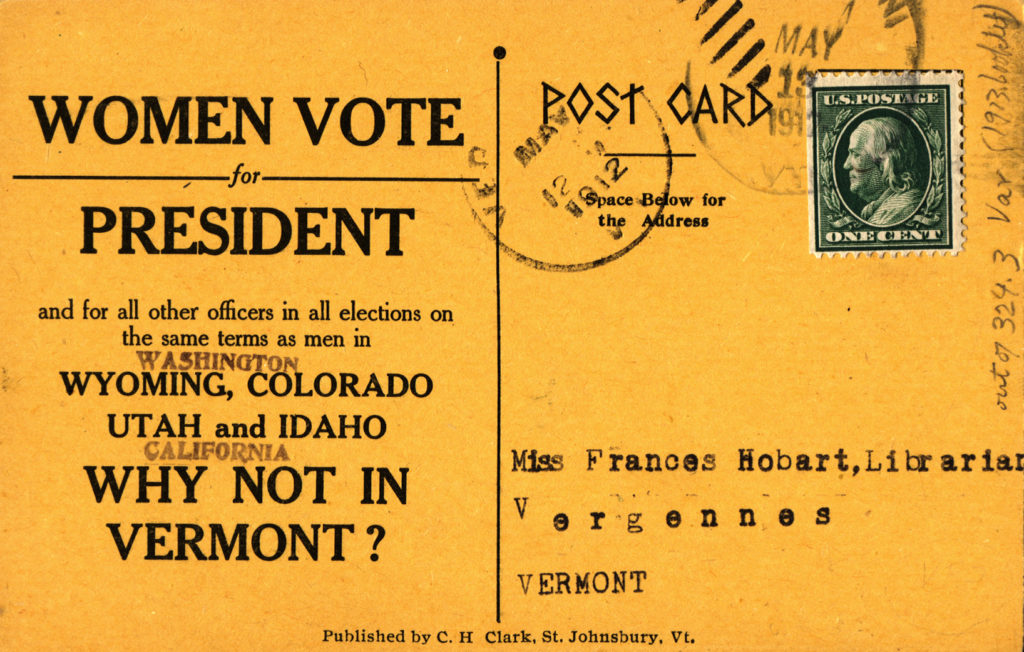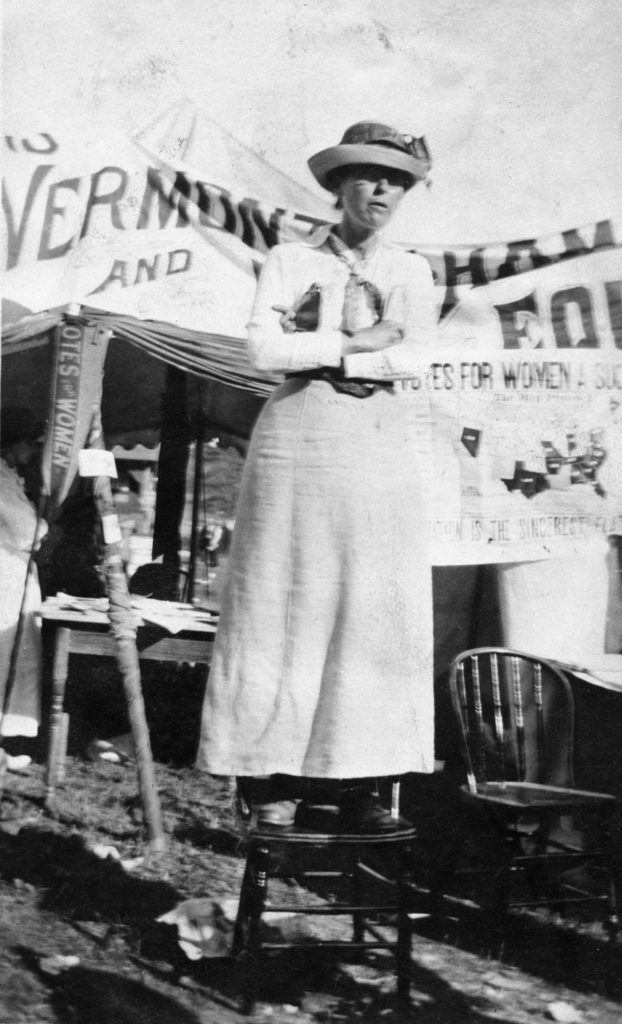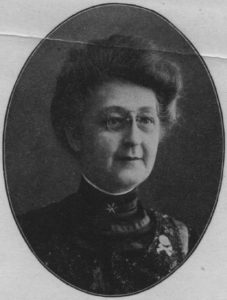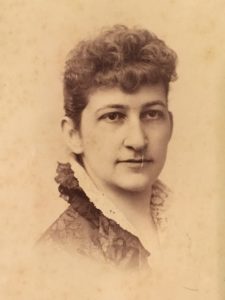
Timeline
1776-1807
July
Elizabeth Cady Stanton supports woman suffrage at the Seneca Falls Convention, where women issue the “Declaration of Rights and Sentiments.”
May
Sojourner Truth gives her “Ain’t I a Woman” speech at the Women’s Rights Convention in Akron, Ohio.
October
Clarina Howard Nichols (Townshend, VT) addresses the Second Women’s Rights Convention in Worcester, Massachusetts, and gains a national reputation.
October
Nichols petitions for women’s right to vote in school meetings and addresses the Vermont Legislature about married women’s property rights.
After migrating to Kansas, Nichols participates in writing the Kansas Constitution which provides equal rights for women in school affairs, including voting in school meetings.
July
Ratification of the 14th Amendment which guarantees equal protection to all citizens but provides suffrage only to men.
May
Elizabeth Cady Stanton and Susan B. Anthony form the National Woman’s Suffrage Association (NWSA) to advocate for a federal Constitutional amendment.
June
Vermont Council of Censors recommends woman suffrage amendment to the Vermont Constitution.
September
The territory of Wyoming grants women the right to vote and hold office.
November
Lucy Stone, Julia Ward Howe, and Henry Blackwell form the American Woman Suffrage Association (AWSA) to advocate for state amendments.
January
Vermont editors, ministers, and lawyers organize Vermont Woman Suffrage Association (VWSA).
February
Ratification of the 15th Amendment, which grants black men the right to vote.
Woman Suffrage Convention held in Montpelier; speakers are Julia Ward Howe, Mary Livermore, and Lucy Stone of the AWSA.
June
Vemont Constitutional Convention defeats woman suffrage amendment.
Mary Ann Shadd Cary and 63 other women attempt to vote in Washington, D.C. but are turned away from the polls.
November
Susan B. Anthony is arrested for voting in Rochester, NY; African American abolitionist, Sojourner Truth attempts to vote in Battle Creek, MI, but is turned away.
February
Vermont Woman’s Christian Temperance Union (WCTU) organized.
Woman Suffrage Amendment introduced in U.S. Congress.
February
Mary Ann Shadd Cary organizes the Colored Women’s Progressive Franchise Association in Washington, D.C.
March
Vermont taxpaying women allowed to vote in school districts and hold school offices; women may be elected or appointed as school superintendents or town clerks.
November
VWSA reorganized with President Maria Hidden.
Fall
Hannah Tracy Cutler of AWSA campaigns in Vermont.
November
Municipal suffrage bill introduced in the Vermont House and defeated.
January
First annual meeting of VWSA in Barton; Laura Moore (Barnet, VT) becomes secretary.
Vermont WCTU endorses suffrage; municipal suffrage defeated again.
Vermont WCTU splits over suffrage, and 500 members resign.
Vermont Legislature defeats municipal suffrage bill again.
February
NWSA and AWSA merge to become NAWSA and focus on state constitutional amendments.
July
Wyoming becomes a state with full voting rights for women.
November
Colorado grants woman suffrage.
July
National Association of Colored Women (NACW) formed with suffragists Mary Church Terrell as president and Frances Ellen Watkins Harper as vice president.
Utah (February) and Idaho (November) grant woman suffrage.
In addition to town clerks and school superintendents, women in Vermont may become notaries public and trustees of public libraries.
Women in Vermont may be elected or appointed as town treasurers.
September
Death of VWSA Secretary Laura Moore, the “Saint of Barnet.”
Women may be appointed as members of the Board of Visitors to state institutions to oversee treatment of women only.
October
Parmelee addresses Vermont House Committee on municipal suffrage.
November
State of Washington grants woman suffrage.
October
California grants woman suffrage.
August
Progressive Party becomes first major party to support woman suffrage.
November
Oregon, Kansas, and Arizona grant woman suffrage.
January
Ida B. Wells-Barnett founds the Alpha Suffrage Club in Chicago for African-American women.
April
Alice Paul and Lucy Burns form the Congressional Union for Woman Suffrage which becomes the National Women’s Party (NWP) in 1916.
May
Vermont women coordinate protests and meetings demanding suffrage in 14 Vermont towns.
June
Vermont Federation of Women’s Clubs (VFW) endorses woman suffrage.
November
Nevada and Montana grant woman suffrage.
March
Vermont Legislature passes municipal suffrage for taxpaying women.
November
New York grants woman suffrage.
November
Michigan, South Dakota, and Oklahoma grant woman suffrage.
March
Vermont Legislature passes Presidential suffrage bill; Governor Percival Clement vetoes it. Women over 21 may vote in town meetings after paying the same poll tax as men ($2).
June
Congress passes the 19th Amendment.
February
Carrie Chapman Catt of NAWSA founds the League of Women Voters, a nonpartisan organization dedicated to supporting women’s voting rights.
VESA state organizer Lillian Olzendam (Woodstock, VT) persuades a legislative majority to favor a special session to ratify the 19th Amendment.
April
“March of 400” Vermont women to demand a special legislative session; Governor Percival Clement refuses to call a special session.
August 18th
Harry Thomas Burn casts the deciding vote making Tennessee the 36th and final state to ratify the 19th Amendment.
August 26
The 19th Amendment to the Constitution is signed into law.
November 2nd
First national election in which women had the right to vote in all 48 states.
February 8th
Vermont ratifies the 19th Amendment.
National Women’s Suffrage Timelines
http://tag.rutgers.edu/wp-content/uploads/2014/05/suffrage-timeline.pdf
Source: Rutgers Institute of Politics
http://www.crusadeforthevote.org/timeline/
Source: National Women’s History Museum
http://www.loc.gov/static/collections/women-of-protest/images/detchron.pdf
Source: Library of Congress
National Woman’s Party Timeline



